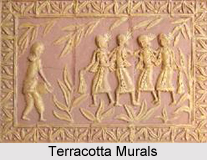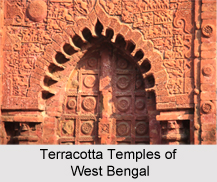 Terracotta Sculpture and Murals are Bengal`s own wealth. Since Bengal lacks stone and has only alluvial deposits, Bengali sculptors choose this reddish clay material for their artwork. The history of Terracotta sculptures start from the Mauryan age (324-187 BC), though there are some evidences of pre-Mauryan sculptures also as found in Harinarayanpur and Pandu Rajar Dhibi of West Bengal.
Terracotta Sculpture and Murals are Bengal`s own wealth. Since Bengal lacks stone and has only alluvial deposits, Bengali sculptors choose this reddish clay material for their artwork. The history of Terracotta sculptures start from the Mauryan age (324-187 BC), though there are some evidences of pre-Mauryan sculptures also as found in Harinarayanpur and Pandu Rajar Dhibi of West Bengal.
In pre-Mauryan time only statue of Sapta Matrikas or Mother- Goddesses prevailed. The art has a long and continuous heritage, as it is evident from the presentation and aesthetic standard of the Mauryan sculpture. The art indicates refined taste and subtle sense of beauty as is found from the facial expression, hairstyle, head-ornaments, dress and jewelry of the sculpture. The sculptures of third century BC found in Tamluk and Chandraketugarh of West Bengal. The faces of the sculptures were first made in moulds and then fixed on handmade bodies.
However, terracotta structures fully made in moulds are found in Tamluk, Chandraketugarh, Pokharna and other places in West Bengal. Most of the figures are of young men and women. Even in these figures also ornaments of fantastic styles, designs and various styles of hairdressings are found.
In the Shunga period (2nd century BC) the sculptures were more monotonous, which became much more elegant, refined and well-shaped in the Kushana period (2nd and 1st century BC). These reliefs were smooth in finishing and more developed example of craftsmanship. Figures were made three-dimensional using two moulds, one for the front and other for the back and finally joining them.
The Terracotta sculptures of this period in Bengal are of better quality than the contemporary stone structures. The excessive ornamentation and attire of this time started disappearing slowly. In the fifth century AD, Terracotta figures of Gods and Goddesses, representatives of Puranic legends and ornamented plaques had first been used in the brick build temples of Mahasthan, Vasu Bihara, Paharpur and Mainamati.
The use of brick became popular in Bengal due to non-availability of stone as well as lack of conveyance and thus developed the practice of decorating the outer surface of temples with plaques. There are still about two thousand Terracotta plaques on the very wide path of the great Somapura Mahavihara at Paharpur built in the 8th and 9th centuries. More than eight hundred of such plaques are collected as they were found scattered round. In these plaques, daily life as well as different occasions and experiences are portrayed while decorating the temple wall. Among these, worth mentioning are nature, man, animals, tribal people, Kinnar-Kinnari (semi-divine beings expert in music and dance), Gandharva (another species of similar semi-divine beings), skinny ascetic on the street can be named.
Like the temples of Paharpur, the pedestals of cross-shaped main temple of Shalvan Vihara at Mainamati were also decorated with a row of terracotta plaque sculptures. In this era the excellent art examples of Terrracotta can be found from Bengal. Much sophisticated versions of plaques compared to that of Paharpur and Mainamati have been found from Bhasu Vihara, which are thirty-four in numbers. These plaques reveal much advancement of style. Half-man, half-fish or flower, pearl string on duck`s beak, elephant, and archer are some noticeable examples of this plaques.
Most Terracotta temples of Bengal were built during the period of late nineteenth century to early nineteenth century. The Bishnupur Temple of Bankura found in seventeenth century and Kantaji`s temple of Dinajpur established on eighteenth century are best examples of this new spirit. Besides, many temples at Howrah, Hoogly, Midnapore, Bardhaman, Birbhum, Nadia, Murshidabad of West Bengal can be considered as remarkable specimens of Terracotta murals.
The artists of Bengal engraved innumerous numbers of Terracotta sculptures based on mythological tales on the wide walls, huge arches, Flat columns, bases of alters and also on the cornices of the temples and mosques. Stories of Ramayana and Mahabharata, Lord Krishna as well as contemporary social life, rituals, men-women, animals and birds, designs of creepers and flowers, hunting scenes and even the imaginary creatures were depicted, which reveal typical Bengali style. In colonial era the lifestyles of Europeans in Bengal along with sensual enjoyment by the zamindar class became the subject of the murals.
Terracotta Sculpture and Murals are Bengal`s own wealth. The history of Terracotta sculptures start from the Mauryan Age (324-187 BC), though there are some evidences of pre-Mauryan sculptures also are as found in Harinarayanpur and Pandu Rajar Dhibi of West Bengal.



